
Tips to help you eat vegetables

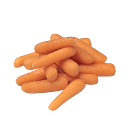 In general: In general:
- Buy fresh vegetables in season. They cost less and are likely to be at their peak flavor.
- Stock up on frozen vegetables for quick and easy cooking in the microwave.
- Buy vegetables that are easy to prepare. Pick up pre-washed bags of salad greens and add baby carrots or grape tomatoes for a salad in minutes. Buy packages of veggies such as baby carrots or celery sticks for quick snacks.
- Use a microwave to quickly “zap” vegetables. White or sweet potatoes can be baked quickly this way.
- Vary your veggie choices to keep meals interesting.
- Try crunchy vegetables, raw or lightly steamed.
For the best nutritional value:
- Select vegetables with more potassium often, such as sweetpotatoes, white potatoes, white beans, tomato products (paste, sauce, and juice), beet greens, soybeans, lima beans, winter squash, spinach, lentils, kidney beans, and split peas.
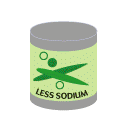 Sauces or seasonings can add calories, fat, and sodium to vegetables. Use the Nutrition Facts label to compare the calories and % Daily Value for fat and sodium in plain and seasoned vegetables. Sauces or seasonings can add calories, fat, and sodium to vegetables. Use the Nutrition Facts label to compare the calories and % Daily Value for fat and sodium in plain and seasoned vegetables. - Prepare more foods from fresh ingredients to lower sodium intake. Most sodium in the food supply comes from packaged or processed foods.
- Buy canned vegetables labeled “no salt added.” If you want to add a little salt it will likely be less than the amount in the regular canned product.
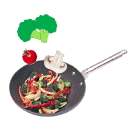 At meals: At meals:
- Plan some meals around a vegetable main dish, such as a vegetable stir-fry or soup. Then add other foods to complement it.
- Try a main dish salad for lunch. Go light on the salad dressing.
- Include a green salad with your dinner every night.
- Shred carrots or zucchini into meatloaf, casseroles, quick breads, and muffins.
- Include chopped vegetables in pasta sauce or lasagna.
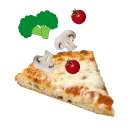 Order a veggie pizza with toppings like mushrooms, green peppers, and onions, and ask for extra veggies. Order a veggie pizza with toppings like mushrooms, green peppers, and onions, and ask for extra veggies.- Use pureed, cooked vegetables such as potatoes to thicken stews, soups and gravies. These add flavor, nutrients, and texture.
- Grill vegetable kabobs as part of a barbecue meal. Try tomatoes, mushrooms, green peppers, and onions.
Make vegetables more appealing:
- Many vegetables taste great with a dip or dressing. Try a low-fat salad dressing with raw broccoli, red and green peppers, celery sticks or cauliflower.
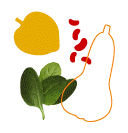 Add color to salads by adding baby carrots, shredded red cabbage, or spinach leaves. Include in-season vegetables for variety through the year. Add color to salads by adding baby carrots, shredded red cabbage, or spinach leaves. Include in-season vegetables for variety through the year. - Include cooked dry beans or peas in flavorful mixed dishes, such as chili or minestrone soup.
- Decorate plates or serving dishes with vegetable slices.
- Keep a bowl of cut-up vegetables in a see-through container in the refrigerator. Carrot and celery sticks are traditional, but consider broccoli florettes, cucumber slices, or red or green pepper strips.
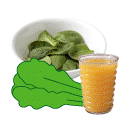 Vegetable tips for children: Vegetable tips for children:
- Set a good example for children by eating vegetables with meals and as snacks.
- Let children decide on the dinner vegetables or what goes into salads.
- Depending on their age, children can help shop for, clean, peel, or cut up vegetables.
- Allow children to pick a new vegetable to try while shopping.
- Use cut-up vegetables as part of afternoon snacks.
- Children often prefer foods served separately. So, rather than mixed vegetables try serving two vegetables separately.
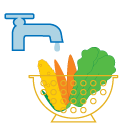 Keep it safe: Keep it safe:
- Wash vegetables before preparing or eating them. Under clean, running water, rub vegetables briskly with your hands to remove dirt and surface microorganisms. Dry after washing.
- Keep vegetables separate from raw meat, poultry and seafood while shopping, preparing, or storing.
This page was last updated on
October 08, 2008 12:42 PM |

|


|
 |

